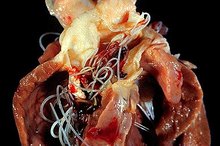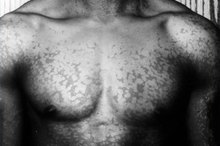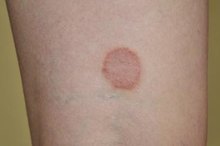Ultraviolet Light Used in Diagnosing Ringworm
Ringworm is a fungal infection that often afflicts cats and dogs and can also infect humans. Symptoms in people include itchiness, redness, and scaly or dry patches of skin. The affected areas often appear as concentric rings, with the center portion healing as the infection moves outward. Diagnosis is often confirmed using ultraviolet light.
If you are experiencing serious medical symptoms, seek emergency treatment immediately.
Ringworm Causes
Although it is known by the name "ringworm," dermatophytosis is a skin infection caused by several types of fungus, not by a type of worm. The fungi include Microsporum canis and Trichophyton rubrum, along with other species. The type of fungus causing the infection cannot be determined just by examining the ringworm-affected areas.
Identifying Ringworm
How to Use Black Light to Diagnose Fungus
Learn More
In some cases, a health care provider will diagnose ringworm based on the appearance of the lesions on a person or animal. In other cases he will use ultraviolet light to determine whether the organisms that cause ringworm are present. If that does not provide a reliable answer, a culture is required to confirm the presence or absence of ringworm-causing fungi.
Identification With UV Light
Some types of fungus that cause ringworm will fluoresce under UV light. M. canis is one of the types that does respond to UV light, but not all of the organisms responsible for ringworm will do so. Experts such as the veterinarians at Long Beach Animal Hospital estimate that about half the time, ringworm species will glow when UV light is shined on them 1. So fluorescence is usually an indication of the presence of ringworm, but lack of fluorescence does not rule it out.
- Some types of fungus that cause ringworm will fluoresce under UV light.
- M. canis is one of the types that does respond to UV light, but not all of the organisms responsible for ringworm will do so.
Wood's Light
Commonly Misdiagnosed Circular Rashes in Children
Learn More
The UV light used for identifying ringworm is often known as a "Wood's lamp" by practitioners. The light in the source is filtered using nickel oxide, and is often called "black light" in common usage. The light itself looks bluish or purplish, and causes some of the organisms responsible for ringworm to appear to glow yellow or green when the light shines on or near the affected area.
- The UV light used for identifying ringworm is often known as a "Wood's lamp" by practitioners.
- The light in the source is filtered using nickel oxide, and is often called "black light" in common usage.
Supplementing Diagnosis With UV Light
Since UV light does not always properly identify the presence of dermatophytes causing ringworm, other techniques are often needed in conjunction with it. Most frequently, hairs or skin cells are used for a culture to determine whether any fungal organisms are present. This technique may also be used to identify the specific species that is present, although treatment is typically the same regardless of the particular species involved.
Related Articles
References
- Long Beach Animal Hospital: Ringworm
- Lecture Notes on Dermatology; Robin Graham-Brown & Tony Burns; 2002
- Centers for Disease Control and Prevention. Fungal Diseases: Ringworm. Updated August 6, 2018.
- Havlickova B, Czaika VA, Friedrich M. Epidemiological trends in skin mycoses worldwide. Mycoses. 2008;51 Suppl 4:2-15. doi:10.1111/j.1439-0507.2008.01606.x
- InformedHealth. Athlete's foot: Overview. Updated June 14, 2018.
- Sentamilselvi G, Janaki C, Murugusundram S. Trichomycoses. Int J Trichology. 2009;1(2):100–107. doi:10.4103/0974-7753.58552
- Raugi G & Nguyen TU. Chapter 22: Superficial Dermatophyte Infections of the Skin. In: Netter's Infectious Diseases. Ed., Jong EC & Stevens DL. 2012:102-109. doi:10.1016/B978-1-4377-0126-5.00022-7
- Gupta AK, Macleod MA, Foley KA, Gupta G, Friedlander SF. Fungal Skin Infections. Pediatr Rev. 2017;38(1):8-22. doi:10.1542/pir.2015-0140
- Tabassum N, Hamdani M. Plants used to treat skin diseases. Pharmacogn Rev. 2014;8(15):52–60. doi:10.4103/0973-7847.125531
- Phillips TG, Slomiany WP, Allison R. Hair Loss: Common Causes and Treatment. Am Fam Physician. 2017;96(6):371-378.
- Andrews, MD, Burns, M. "Common Tinea Infections in Children." Am Fam Physician. 2008 May 15;77(10):1415-20.
- Centers for Disease Control and Prevention. "Definition of Ringworm." Dec 6, 2015.
- Havlickova B, Czaika, VA, Friedrich, M. "Epidemiological Trends in Skin Mycoses Worldwide." Mycoses. 2008 Sep;51 Suppl 4:2-15. DOI: 10.1111/j.1439-0507.2008.01606.x.
- Mounsey, AL and Reed, SW. "Diagnosing and Treating Hair Loss." American Family Physician. Aug 15, 2009. 80.4(2009), 356-362.









